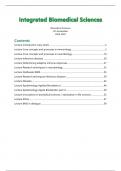Samenvatting
SUMMARY Integrated biomedical sciences (AM_1281); VU Amsterdam; Biomedical Sciences Year 1
This document contains an elaborate summary of all the lectures given during the course Integrated Biomedical Sciences at the Vrije Universiteit Amsterdam. It was made in 2024. Good luck studying!
[Meer zien]













